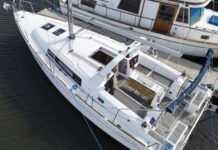There is much confusion on pipe. Pipe is measured in nominal sizes that have nothing to do with any dimensions on the pipe, except in very large sizes. The abbreviation IPS is often used to denote pipe nominal size. For any pipe size, the OD (outside diameter) will be the same, with various wall thicknesses. Most common is schedule 40, which is considered to be the standard. Schedule 80 has a thicker wall and is sometimes referred to as extra strong or XS. Schedule 10 has a very thin wall, often used for irrigation where there is little pressure.
Pipe is available in a variety of materials. The most common on yachts is black iron, which is used for engine exhaust; bronze/brass used for through hulls; and PVC. Any PVC used below the waterline should be schedule 80, which is generally a dark gray in color.
Other abbreviations commonly used: MPT (male pipe thread); FPT (female pipe thread).
A lot of spinnaker poles are made from schedule 10 aluminum pipe, a fact that once came in handy to a Tartan 41 owner. He was racing the St. Francis YC big boat series, and the crew managed to break the pole. At the time, I was employed at Tartan, and I got a panic call asking me to overnight air freight a new spinnaker pole. I told the owner that the cost would be exorbitant, and recommended he send the crew out to forage the irrigated fields. He called back the following day to say that a San Fernando farmer had one less length of pipe, but a full case of beer. The spinnaker pole worked fine.
In addition to IPS sizes, plastic PVC pipe is available in nominal inch sizes with a thin wall, called DWV, an abbreviation for drain, waste, vent. This pipe should not be used for any pressure applications, and is always terminated with solvent weld fittings. The best use I have found for DWV is 12″ long sections stacked up to make a wine rack.
PVC pipe-to-hose adapters are readily available, but they are made to fit the ID (inside diameter) of plastic pipe, NOT the ID of hose. Only one size works well: A 1/2 IPS barb adapter fits 5/8″ ID hose. Do not use any other sizes, as forcing hose on may collapse the fitting internally or rupture the hose. Shields and Forespar make reinforced plastic pipe thread-to-hose adapters that are sized to the ID of marine hose. A note on Forespar fittings: There is an unthreaded portion at the end of the threads that must be ground off to allow the fitting to screw into anything.
When using bronze/brass pipe on through hulls or anywhere underwater, be aware that some bronze alloys can contain 22% zinc, which may be attacked by electrolysis, leaving a porous, weak fitting. Manufacture of bronze/brass pipe fittings has largely moved overseas to Third World countries where careful analysis of alloys is not assured. Never use brass below the waterline. Never screw brass fittings into aluminum tanks. Use stainless steel between brass and aluminum, but still use an insulating paste on the stainless threads.
Most pipe threads are tapered (think of a wood screw). Straight pipe threads are used on some through hull/seacock combinations to allow the through hull to screw into the seacock body varying amounts, depending on hull thickness. (As noted on p. 4 of the April 1 issue, one should use a seacock with NPS straight threads on the bottom to match NPS threads of the through hull.) The table below also shows the necessary thread engagement length to achieve a tight joint with tapered pipe threads.
For pipe joint compound, I like Rectorseal #5. Unlike Teflon tape, fittings can be backed off a little and still not leak.
-Bill Seifert



































